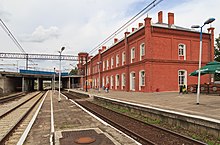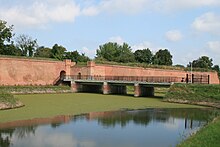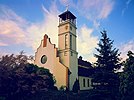Kostrzyn nad Odrą
Kostrzyn nad Odrą | ||
|---|---|---|
| ||
|
Car plates FGW | | |
| Climate | Cfb | |
| National roads | ||
| Voivodeship roads | ||
| Website | http://www.kostrzyn.pl | |
Kostrzyn nad Odrą (translated literally as Kostrzyn upon the Oder; Polish pronunciation: [ˈkɔst.ʂɨn ˌnad ˈɔdrɔ̃]; German: Küstrin [kʏsˈtʁiːn]) is a town in Gorzów County, Lubusz Voivodeship in western Poland, on the border with Germany.
Geography
The town is situated within the historic Lubusz Land (Ziemia Lubuska) region at the confluence of the Oder and Warta rivers, on the western rim of the extended Warta mires. The town centre is located about 90 kilometres (56 mi) south of Szczecin.
Until the end of World War II and the implementation of the Oder–Neisse line in 1945, the municipal area also comprised the Küstrin-Kietz suburb on the west bank of the Oder river, which today is part of the German Küstriner Vorland municipality. The former town centre, the Kostrzyn fortress located on the headland between the Oder and Warta rivers, was destroyed by the Red Army as an act of revenge weeks before the end of WW2 and not rebuilt. Today Kostrzyn's central area is located around Kostrzyn railway station east of the Warta's mouth.
History
Middle Ages

Settled since the
In 1223 the
In 1373 the town became part of the
Modern era


In 1535–1571 the town was the seat of
In September 1923, the

After the war the ruined town became again part of Poland by decision of the
The remnants of the old town within the fortress walls, including the castle in which the young Frederick the Great had been imprisoned, were razed after the war and the bricks were used to rebuild Polish cities elsewhere. More recently, plans to rebuild some of the old town in a historical style were considered, but this project appears to be on hold. The section of the town on the west bank of the Oder remained in Germany and is now called Küstrin-Kietz. Between 2004 and 2019 Kostrzyn hosted the annual Pol'and'Rock Festival (formerly Przystanek Woodstock) in the summer, the largest open-air music festival in Europe and one of the largest in the world.


Population in selected years
- 1900: 16,473
- 1925: approx. 19,500
- 1939: approx. 24,000
- 1971: approx. 11,000
Note that the above numbers are based on primary, possibly inaccurate or biased sources.[7][8][9]


Sports
The local football club is Celuloza Kostrzyn nad Odrą. It competes in the lower leagues.
Notable people
- Archbishop of Gniezno
- Kaspar von Barth (1587–1658), philologist
- Christian Albert, Burgrave and Count of Dohna (1621–1677), Prussian general
- Philipp von Stosch (1691–1757), Prussian antiquarian
- Alfred von Tirpitz (1849–1930), German grand admiral
- Fedor von Bock (1880–1945), German field marshal
- Gerhard Matzky (1894–1983), German general
- Joseph Kushner (1922–1985), American property developer
- Dariusz Dudka (born 1983), Polish footballer
- Grzegorz Wojtkowiak (born 1984), Polish footballer
- Łukasz Fabiański (born 1985), Polish footballer
Twin towns – sister cities
Kostrzyn nad Odrą is twinned with:
References
- ^ "Population. Size and structure and vital statistics in Poland by territorial division in 2019. As of 30th June". stat.gov.pl. Statistics Poland. 2019-10-15. Retrieved 2020-02-24.
- ^ "Kostrzyn nad Odrą". Web.archive.org. 2006-03-06. Archived from the original on March 6, 2006. Retrieved 2013-03-26.
- ^ Zakład Narodowy im. Ossolińskich, Wydawnictwo Polskiej Akademii Nauk: 489.
- ^ Rogalski, Leon (1846). Dzieje Krzyżaków oraz ich stosunki z Polską, Litwą i Prussami, poprzedzone rysem dziejów wojen krzyżowych. Tom II (in Polish). Warszawa. pp. 59–60.
- ^ Umiński, Janusz (1998). "Losy internowanych na Pomorzu żołnierzy powstania listopadowego". Jantarowe Szlaki (in Polish). No. 4 (250). p. 16.
- ^ ISBN 978-0-253-06089-1.
- ^ Meyers Konversations-Lexikon (in German). Vol. 11 (6th ed.). Leipzig and Vienna. 1908. p. 890.
{{cite book}}: CS1 maint: location missing publisher (link) - ^ Der Große Brockhaus (in German). Vol. 12 (15th ed.). Leipzig. 1931. p. 788.
{{cite book}}: CS1 maint: location missing publisher (link) - ^ Meyers Enzyklopädisches Lexikon (in German). Vol. 14 (9th ed.). Mannheim/Vienna/Zürich. 1975. p. 511.
{{cite book}}: CS1 maint: location missing publisher (link) - ^ "Städtepartnerschaften". seelow.de (in German). Seelow. Retrieved 2020-03-24.
- ^ "Uchwała w sprawie porozumienia partnerskiego z miastem Peitz". kostrzyn.nowoczesnagmina.pl (in Polish). Kostrzyn. Retrieved 2022-05-28.
- ^ "Uchwała w sprawie porozumienia partnerskiego z miastem Sambor". kostrzyn.nowoczesnagmina.pl (in Polish). Kostrzyn. Retrieved 2022-05-28.
External links
- Municipal website (in Polish)
- Jewish Community in Kostrzyn nad Odrą on Virtual Shtetl
- Google Maps
- Webpage of the municipality on the German side of the border (in German)
- Gallery of old photos
- Information about the fortress Küstrin






